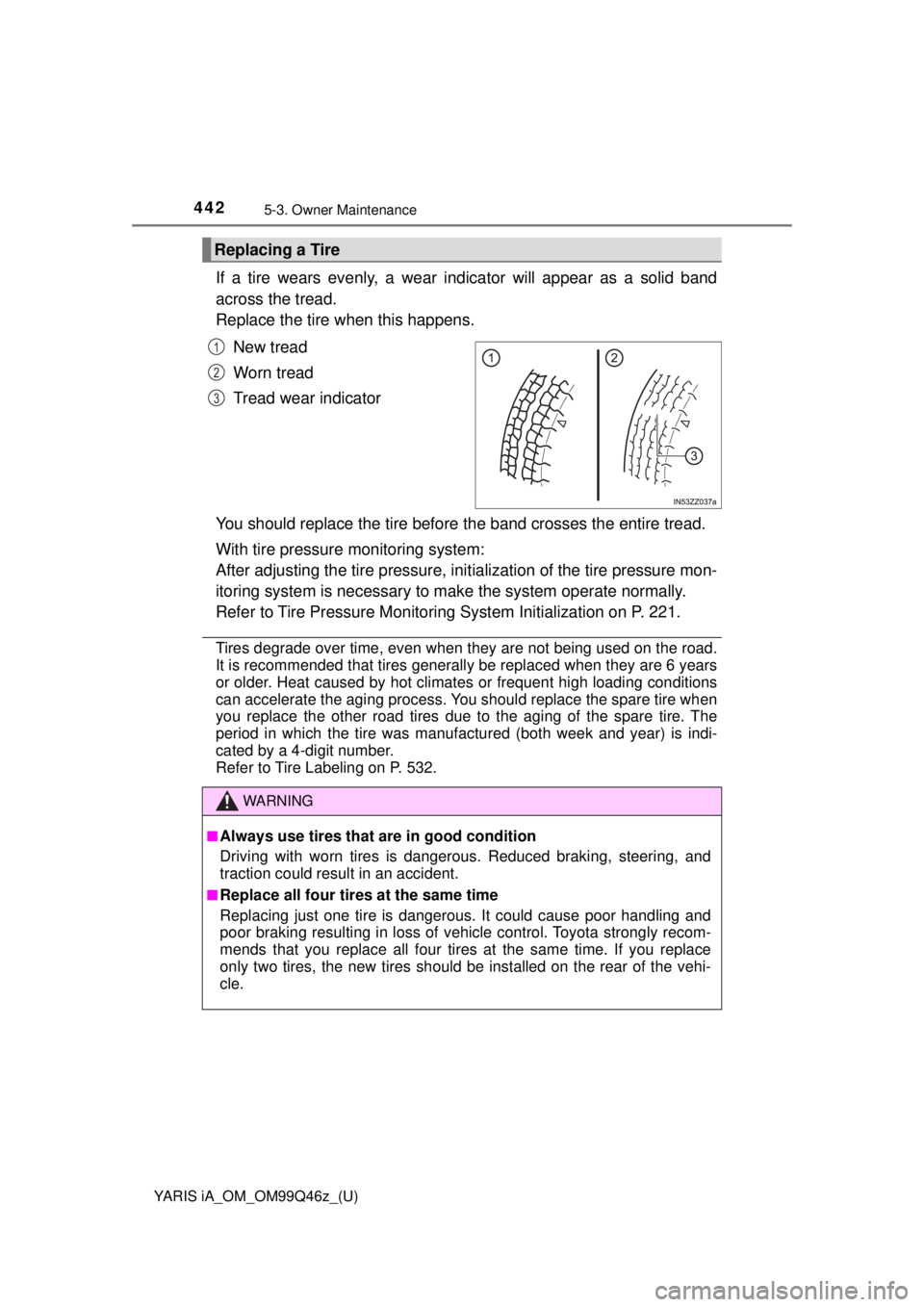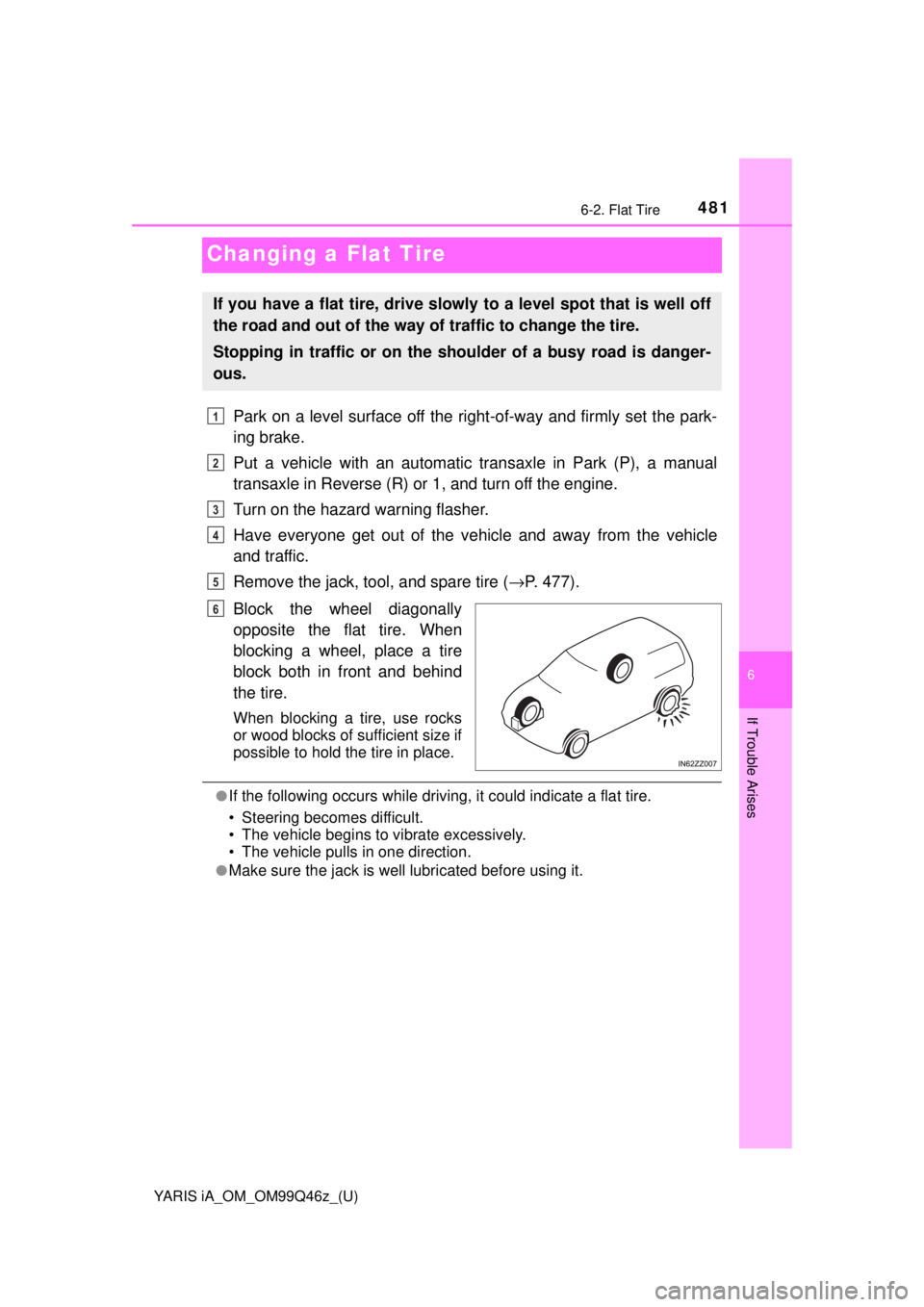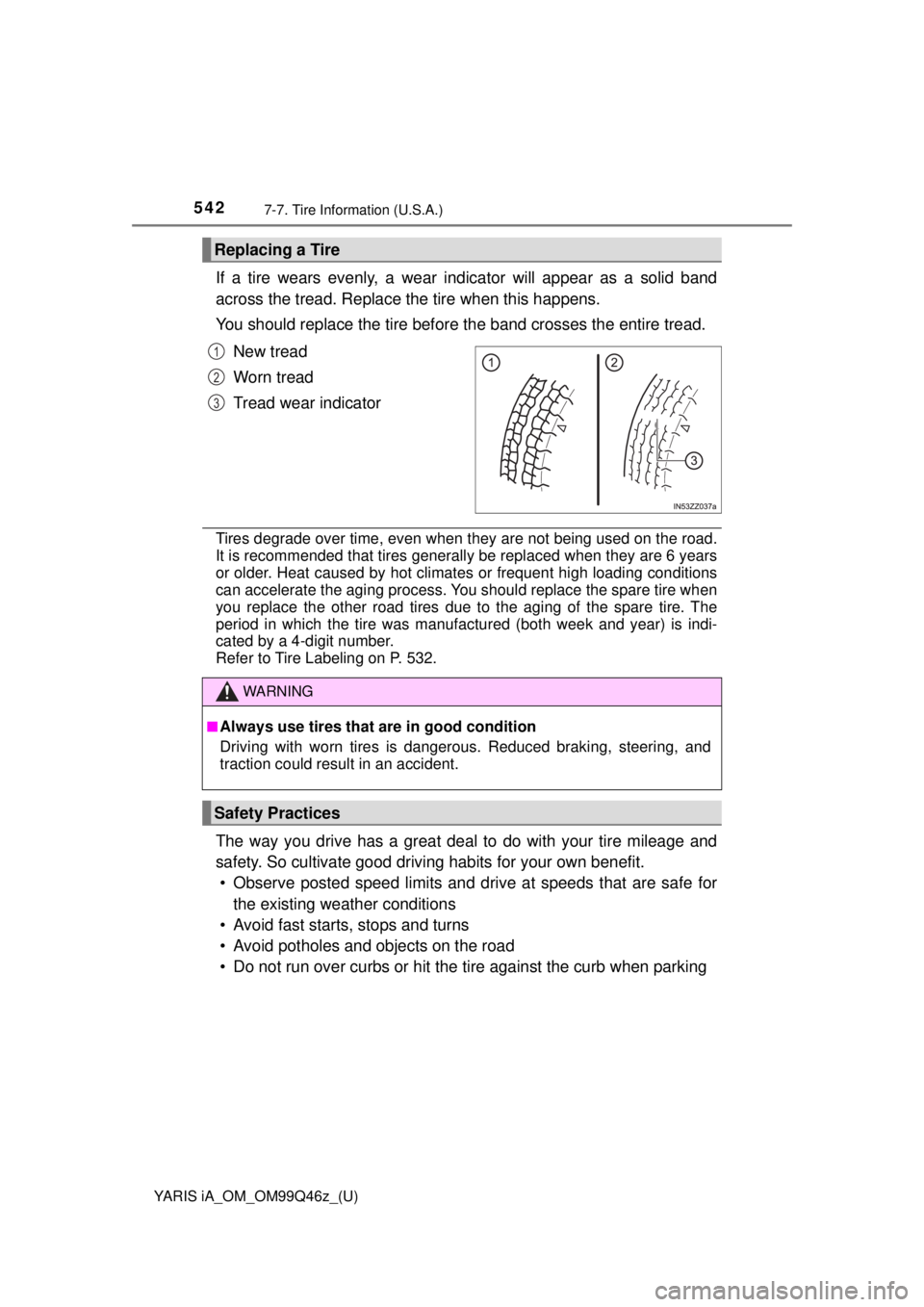2018 TOYOTA YARIS iA steering
[x] Cancel search: steeringPage 442 of 576

4425-3. Owner Maintenance
YARIS iA_OM_OM99Q46z_(U)
If a tire wears evenly, a wear indicator will appear as a solid band
across the tread.
Replace the tire when this happens.New tread
Worn tread
Tread wear indicator
You should replace the tire before the band crosses the entire tread.
With tire pressure monitoring system:
After adjusting the tire pressure, init ialization of the tire pressure mon-
itoring system is necessary to make the system operate normally.
Refer to Tire Pressure Monitoring System Initialization on P. 221.
Tires degrade over time, even when they are not being used on the road.
It is recommended that tires generally be replaced when they are 6 years
or older. Heat caused by hot climates or frequent high loading conditions
can accelerate the aging process. You should replace the spare tire when
you replace the other road tires due to the aging of the spare tire. The
period in which the tire was manufactured (both week and year) is indi-
cated by a 4-digit number.
Refer to Tire Labeling on P. 532.
Replacing a Tire
1
2
3
WARNING
■Always use tires that are in good condition
Driving with worn tires is dangerous. Reduced braking, steering, and
traction could result in an accident.
■Replace all four tires at the same time
Replacing just one tire is dangerous. It could cause poor handling and
poor braking resulting in loss of vehi cle control. Toyota strongly recom-
mends that you replace all four tires at the same time. If you replace
only two tires, the new tires should be installed on the rear of the vehi-
cle.
Page 481 of 576

481
YARIS iA_OM_OM99Q46z_(U)
6-2. Flat Tire
6
If Trouble Arises
Changing a Flat Tire
Park on a level surface off the right-of-way and firmly set the park-
ing brake.
Put a vehicle with an automatic transaxle in Park (P), a manual
transaxle in Reverse (R) or 1, and turn off the engine.
Turn on the hazard warning flasher.
Have everyone get out of the vehicle and away from the vehicle
and traffic.
Remove the jack, tool, and spare tire ( →P. 477).
Block the wheel diagonally
opposite the flat tire. When
blocking a wheel, place a tire
block both in front and behind
the tire.
When blocking a tire, use rocks
or wood blocks of sufficient size if
possible to hold the tire in place.
●If the following occurs wh ile driving, it could indicate a flat tire.
• Steering becomes difficult.
• The vehicle begins to vibrate excessively.
• The vehicle pulls in one direction.
●Make sure the jack is well lubricated before using it.
If you have a flat tire, drive slowly to a level spot that is well off
the road and out of the way of traffic to change the tire.
Stopping in traffic or on the shoulder of a busy road is danger-
ous.
1
2
3
4
5
6
Page 503 of 576

YARIS iA_OM_OM99Q46z_(U)
5036-7. Warning/Indicator Lights and Warning Sounds
6
If Trouble Arises
(Red)
High Engine Coolant Temperature Warning LightThe light flashes when the engine coolant temperature is
extremely high, and illuminates when the engine coolant
temperature increases further.
Handling Procedure:
• Flashing light
Drive slowly to reduce engine load until you can find a
safe place to stop the vehicle and wait for the engine to
cool down.
• Illuminated light This indicates the possibility of overheating. Park the
vehicle in a safe place immediately and stop the engine.
Refer to Overheating P. 496.
Power Steering Malfunction Indicator Light
The light illuminates/flashes if the electric power steering
has a malfunction.
If the light illuminates/flashes, stop the vehicle in a safe
place and do not operate the steering wheel. There is no
problem if the light turns off after a while. Contact your
Toyota dealer if the light illuminates/flashes continuously.
SignalWarning
Page 504 of 576

5046-7. Warning/Indicator Lights and Warning Sounds
YARIS iA_OM_OM99Q46z_(U)
■Power Steering Malfunction Indicator Light
●If the indicator light illuminates/flashes, the power steering will not operate
normally. If this happens, the steering wheel can still be operated, however,
the operation may feel heavy compared to normal, or the steering wheel
could vibrate when turning.
● Repeatedly jerking the steering wheel left and right while the vehicle is
stopped or moving extremely slowly will cause the power steering system to
go into protective mode which will make the steering feel heavy, but this
does not indicate a problem. If this occurs, park the vehicle safely and wait
several minutes for the system to return to normal.
WARNING
■Do not drive with the brake system warning light illuminated. Contact
your Toyota dealer to have the brakes inspected as soon as possible
Driving with the brake system warning light illuminated is dangerous. It indi-
cates that your brakes may not work at all or that they could completely fail
at any time. If this light remains illuminated, after checking that the parking
brake is fully released, have the brakes inspected immediately.
In addition, the effectiveness of the braking may diminish so you may need
to depress the brake pedal more strongly than normal to stop the vehicle.
■ Do not drive with both the ABS warning light and brake warning light
illuminated. Have the vehicle towed to your Toyota dealer to have the
brakes inspected as soon as possible
Driving when the brake system warning light and ABS warning light are illu-
minated simultaneously is dangerous.
When both lights are illuminated, the rear wheels could lock more quickly in
an emergency stop than under normal circumstances.
NOTICE
■ Charging System Warning Light
Do not continue driving when the charging system warning light is illumi-
nated because the engine could stop unexpectedly.
■ Engine Oil Warning Light
● Do not run the engine if the oil pressure is low. Otherwise, it could result in
extensive engine damage.
● Do not run the engine if the oil level is low. Otherwise, it could result in
extensive engine damage.
■ High Engine Coolant Temperature Warning Light
Do not drive the vehicle with the high engine coolant temperature warning
light illuminated. Otherwise, it could result in damage to the engine.
Page 516 of 576

5166-7. Warning/Indicator Lights and Warning Sounds
YARIS iA_OM_OM99Q46z_(U)
If the driver’s door is opened while the ignition is switched to ACC, a
continuous beep sound will be heard to notify th e driver that the igni-
tion has not been switched off (STOP). Left in this condition, the key-
less entry system will not operate, the car cannot be locked, and the
battery power will be depleted.
A beep sound will be hear d 6 times and the KEY warning light (red)
will flash continuously if the ignition has not been switched off, all the
doors are closed, and the key is remo ved from the vehicle. This is to
notify the driver that the key has been removed from the vehicle and
the ignition has not been switched off.
Because the key utilizes low-intensity radio waves, the Key Removed From
Vehicle Warning may activate if the key is carried together with a metal object
or it is placed in a poor signal reception area.
The warning beep sound will be heard for about 3 seconds when
there is any abnormality in tire inflation pressures (→P. 218).
If there is the possibility of a collis ion with a vehicle ahead, the beep
sounds continuously and a warning is indicated in the display.
If the power steering system has a malfunction, the power steering
malfunction light turns on or flashes and the buzzer operates at the
same time.
Refer to Warning/Indicator Lights on P. 156.
Ignition Not Switched Off (STOP) Warning Beep
Key Removed from Vehicle Warning Beep
Tire Inflation Pressure Warning Beep (if equipped)
Collision warning (if equipped)
Power Steering Warning Buzzer
Page 542 of 576

542
YARIS iA_OM_OM99Q46z_(U)
7-7. Tire Information (U.S.A.)
If a tire wears evenly, a wear indicator will appear as a solid band
across the tread. Replace the tire when this happens.
You should replace the tire before the band crosses the entire tread.
New tread
Worn tread
Tread wear indicator
Tires degrade over time, even when they are not being used on the road.
It is recommended that tires generally be replaced when they are 6 years
or older. Heat caused by hot climates or frequent high loading conditions
can accelerate the aging process. You should replace the spare tire when
you replace the other road tires due to the aging of the spare tire. The
period in which the tire was manufactured (both week and year) is indi-
cated by a 4-digit number.
Refer to Tire Labeling on P. 532.
The way you drive has a great deal to do with your tire mileage and
safety. So cultivate good driving habits for your own benefit. • Observe posted speed limits and drive at speeds that are safe for the existing weather conditions
• Avoid fast starts, stops and turns
• Avoid potholes and objects on the road
• Do not run over curbs or hit the tire against the curb when parking
Replacing a Tire
1
2
3
WARNING
■Always use tires that are in good condition
Driving with worn tires is dangerous. Reduced braking, steering, and
traction could result in an accident.
Safety Practices
Page 548 of 576

548
YARIS iA_OM_OM99Q46z_(U)
7-7. Tire Information (U.S.A.)
GCWR (Gross Combination Weight Rating) is the maximum allowable
weight of the vehicle - including all cargo and passengers - that the
vehicle can handle without risking damage. The GCW must never
exceed the GCWR.
WARNING
■Do not tow a trailer with this vehicle
Towing a trailer with this vehicle is dangerous because it has not been
designed to tow a trailer and doing so will affect the drive system which
could result in vehicle damage.
■Overloaded Vehicle
Overloading a vehicle is dangerous. The results of overloading can
have serious consequences in terms of passenger safety. Too much
weight on a vehicle’s suspension system can cause spring or shock
absorber failure, brake failure, handling or steering problems, irregular
tire wear, tire failure or other damage.
Overloading makes a vehicle harder to drive and control. It also
increases the distance requ ired for stopping. In cases of serious over-
loading, brakes can fail completely, particularly on steep grades. The
load a tire will carry safely is a combin ation of the size of the tire, its load
range, and corresponding inflation pressure.
Never overload the vehicle and always observe the vehicle’s weight rat-
ings from the vehicle’s Safety Cert ification and Tire and Load Informa-
tion labels.
■Never Exceed Axle Weight Rating Limits
Exceeding the Safety Certification Label axle weight rating limits is dan-
gerous and could result in death or serious injury as a result of substan-
dard vehicle handling, performanc e, engine, transmission and/or
structural damage, serious damage to the vehicle, or loss of control.
Always keep the vehicle within the axle weight rating limits.
■Never Exceed GVWR or GAWR Specifications
Exceeding the GVWR or the GAWR sp ecified on the certification label is
dangerous. Exceeding any vehicle rating limitation could result in a seri-
ous accident, injury, or damage to the vehicle.
Do not use replacement tires with lower load carrying capacities than
the originals because they may lo wer the vehicle’s GVWR and GAWR
limitations. Replacement tires with a higher limit than the originals do
not increase the GVWR and GAWR limitations. Never exceed the
GVWR or the GAWR specified on the certification label.
Page 574 of 576

574Alphabetical index
YARIS iA_OM_OM99Q46z_(U)
Parking Brake .......................... 188
Power Steering ........................ 203
Power Windows ....................... 116
Power steering warning buzzer ..................................... 516
Rear Coat Hooks...................... 409
Rear Door Ch ild Safety
Locks ...................................... 102
Rear Seat .................................... 24
Rear View Monitor ................... 222
Displayable range on the screen................................. 224
Picture quality adjustment..... 231
Rear view monitor operation ............................ 227
Rear view parking camera location ............................... 223
Switching to the rear view
monitor display ................... 223
Variance between actual road conditions and
displayed Image ................. 229
Viewing the display ............... 226
Rear Window Defogger ........... 185
Rearview Mirror ....................... 114
Recommended Oil ................... 422
Recreational Towing ............... 137
Replacement Fuse ...................................... 455
Key battery............................ 436
Light Bulbs ............................ 445
Tires ...................................... 442
Wheel.................................... 443
Wiper .................................... 432
Rocking the Vehicle ................ 129 Safety Defects, Reporting....... 520
Saving Fuel and Protection
of the Environment ............... 126
Seat Belt System ....................... 34 Automatic locking ................... 33
Emergency locking ................. 33
Extender ................................. 39
Pregnant women .................... 32
Seat belt precautions .............. 30
Seat belt warning beep ........... 515
Seats Front seat ............................... 21
Head restraint ......................... 27
Rear seat ................................ 24
Seat warmer ........................... 22
Security System Immobilizer system ............... 120
Theft-deterrent
system .......... ...................... 122
Smart City Brake Support
(SCBS).................................... 205
Smart key ................................... 89
Spare Tire ................................. 479
Specifications .......................... 556
Speedometer............................ 148
SRS Air Bags Front passenger occupant
classification syst em ............ 78
How the SRS air bags work...................................... 70
Limitations to SRS air bag ...... 76
Monitoring ............................... 83
SRS air bag deployment criteria .................................. 74
Supplemental restraint system components ............. 69
P
R
S